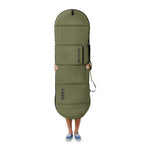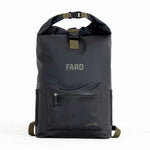If you’ve ever discovered a ding or scratch on your surfboard after a quick trip to the beach, you know how frustrating it can be. Surfboards aren’t just expensive they’re the core of your surfing lifestyle. Protecting them is essential. That’s where surfboard bags come in. A surfboard bag is more than just a cover; it’s an investment in the longevity, safety, and performance of your board.
In this guide, we’ll break down why surfboard bags are worth it, the different types available, what features to look for, common mistakes to avoid, and why FARO Surfboard Bags stand out as one of the best options on the market.
Why Surfboard Protection Matters
Surfboards are constantly at risk of damage—from car rides to the beach, bumpy airline travel, or simply sitting in the sun. Dings, scratches, and UV exposure can shorten your board’s lifespan and impact performance.
A surfboard bag acts as a barrier, keeping your board safe from the elements and everyday accidents. While some surfers rely on towels, blankets, or makeshift covers, these don’t provide reliable protection. A purpose-built surfboard bag is specifically designed to guard against bumps, heat, and moisture ensuring your board stays in top condition for years.
Think about how much you spend on your board. Even a small crack or delamination can cost hundreds to repair. A quality surfboard bag, on the other hand, is a one-time investment that prevents recurring damage.
The Benefits of Surfboard Bags
1. Protection and Durability
The number one reason to invest in a surfboard bag is protection. Whether you’re heading down the street or across the globe, your board is vulnerable.
Surfboard bags:
-
Shield against scratches, dents, and dings
-
Prevent UV damage that can weaken your board’s glassing
-
Offer extra padding to absorb impacts during transport
-
Use reinforced stitching and materials to withstand years of use
A surfboard bag doesn’t just protect your board today, it helps extend its lifespan so you don’t have to replace it prematurely.
2. Convenience and Travel
Carrying a surfboard without a bag can be awkward and tiring. Surfboard bags make transport easier with:
-
Shoulder straps and padded handles for comfort
-
Streamlined shapes that make boards easier to maneuver
-
Secure enclosures that prevent sliding in your car or truck
For air travel, a surfboard bag is a must. Airlines often charge for oversized luggage, and without a bag, your surfboard can be damaged by rough handling. A padded surfboard bag minimizes these risks and ensures your board arrives safely at your destination.
Many traveling surfers have horror stories of picking up their boards at baggage claim only to find cracks, pressure dents, or snapped fins. A quality travel bag cushions your surfboard and gives you peace of mind.
3. Organization and Storage
A good surfboard bag isn’t just for transport—it also makes storage easier. When your board isn’t in use, a bag:
-
Protects against dust and moisture buildup
-
Prevents heat damage from garages, sheds, or car trunks
-
Keeps boards safe from accidental knocks in storage spaces
Many surfboard bags also include compartments for wax, fins, leashes, and towels, keeping all your gear in one organized place. This makes packing for a surf trip faster and stress-free.
Types of Surfboard Bags
Not all surfboard bags are the same. Choosing the right one depends on your needs, how often you travel, and what conditions you’ll face.
1. Day Bags
Day bags are lightweight, padded covers meant for short trips and daily protection. They usually feature a reflective exterior and minimal padding. Perfect if you’re driving to your local break and want to keep your board cool and scratch-free.
2. Travel Bags
Travel bags are built for longer journeys and airline use. They have heavy-duty padding, reinforced nose and tail sections, and extra compartments for gear. Some can carry multiple boards, making them ideal for surf trips abroad.
3. Sock Covers
A surfboard sock is a stretchable, fabric cover that protects against scratches and UV rays but doesn’t offer much impact resistance. They’re best for indoor storage or carrying your board in and out of the house.
4. Hybrid Bags
These combine features of day bags and travel bags, offering more padding than a standard day bag but less bulk than a heavy travel bag. Great for road trips or situations where you need moderate protection.
By understanding the differences, you can select the best type of bag for your lifestyle.

Special Features to Look For in Surfboard Bags
High-quality designs come with features that make them more effective and convenient. Some important details to check include:
-
Padded interiors to absorb shock and prevent scratches
-
Ventilation systems that reduce heat buildup and moisture
-
Additional pockets for fins, wax, wetsuits, or travel essentials
-
Heat-reflective exteriors that keep boards cool under direct sunlight
-
Heavy-duty zippers that won’t corrode in salty, sandy conditions
A surfboard bag with these features doesn’t just serve as protection it becomes an all-in-one surf travel companion.
Why FARO Surfboard Bags Stand Out
When it comes to combining durability, function, and style, Surfboard Bags are among the best on the market. Surfers who travel, store boards for long periods, or just want reliable everyday protection appreciate their thoughtful design.
Key Benefits of FARO Surfboard Bags:
-
Superior padding: High-density foam ensures maximum shock absorption.
-
Heat-reflective exterior: Keeps your board safe from UV damage and overheating.
-
Reinforced stitching: Designed to withstand years of regular use.
-
Extra compartments: Built-in pockets for accessories like fins, wax, and wetsuits.
-
Comfort features: Ergonomic handles and adjustable straps for easy carrying.
With FARO, you’re not just buying a surfboard bag—you’re investing in long-term board protection and convenience. Whether you’re road-tripping up the coast, flying overseas, or simply storing your board at home, FARO ensures your surfboard is safe and travel-ready.
Protect Your Board Today
Common Mistakes to Avoid When Buying a Surfboard Bag
Even experienced surfers sometimes choose the wrong bag. Here are some pitfalls to avoid:
-
Buying the wrong size: A bag that’s too big lets the board shift around, increasing damage risk. Too small, and your board won’t fit. Always measure first.
-
Ignoring padding quality: Thin padding might save money but won’t protect your board during travel.
-
Choosing cheap materials: Bargain bags often have zippers that corrode or fabrics that tear after a few uses.
-
Forgetting extra storage: Pockets for fins, wax, and leashes save hassle when traveling.
-
Not considering your surf style: If you travel frequently, a day bag won’t cut it you’ll need a premium travel bag.
How to Care for Your Surfboard Bag
A surfboard bag is a long-term investment, and with proper care, it can last for years. Follow these tips to extend its lifespan:
-
Rinse after use: Saltwater and sand can corrode zippers and weaken fabric. Give it a freshwater rinse when possible.
-
Dry before storage: Never leave your bag wet in a closed space; it can cause mold and odors.
-
Store in a cool, dry place: Heat can damage the reflective coating and weaken padding.
-
Check zippers regularly: Apply zipper lubricant or wax to prevent sticking.
-
Avoid overstuffing: Don’t cram too many boards or gear into one bag unless it’s designed for it.
By caring for your surfboard bag, you ensure it continues protecting your board for the long haul.

Factors to Consider When Choosing a Surfboard Bag
Before purchasing, make sure the bag you choose fits your needs. Here’s what to keep in mind:
1. Size and Fit
Measure your surfboard and select a bag that matches its length and width. A snug fit provides the best protection without extra bulk.
2. Padding and Protection
Look for bags with thick padding, nose and tail protectors, and reinforced seams. These are the areas most vulnerable to impact during travel.
3. Durability and Materials
Choose heavy-duty fabrics like canvas surfboard bags, polyester, or ripstop nylon. Salt, sand, and UV rays can quickly wear down cheap materials.
4. Travel Needs
If you’re flying with your board, choose a travel-specific bag with multi-layer padding, extra reinforcement, and lockable zippers. Local trips may not require as much protection, but frequent flyers should always invest in a premium travel bag.
5. Price and Value
Surfboard bags range in price from budget-friendly day bags to premium travel bags. While higher-end options like FARO offer maximum protection, even mid-range bags can add years to your board’s life. Think of it this way: one repair often costs more than a good bag.
Conclusion: Are Surfboard Bags Worth It?
Yes, surfboard bags are absolutely worth it. From preventing costly damage to making travel and storage easier, a good surfboard bag is a must-have for every surfer. With added features like ventilation, padding, and compartments for accessories, they go far beyond simple protection.
If you want to safeguard your investment, extend the life of your board, and surf with peace of mind, a surfboard bag is the answer. And if you’re looking for the perfect balance of quality, durability, and thoughtful design, FARO Surfboard Bags are one of the best choices available today. Get Your Bag Here





